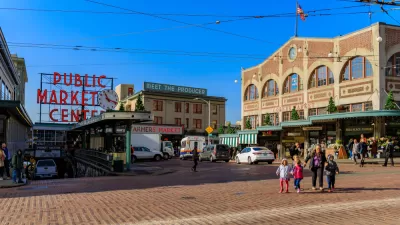Farmers Markets have exploded over the past decade. This phenomenon has not only brought more vegetables to cities but revitalization in the public.
Nothing quite says springtime like a farmer’s table loaded with kale, mustard greens, and spinach. And with the arrival of warmer days, soon communities will be enjoying the benefits of fresh, locally grown produce. Though farmers markets are often criticized over affordability and exclusivity, the appetite for them has grown significantly. In 1994, there were 1,700 markets nationwide; now, there are more than eight thousand. The proliferation of baby bok choy is indeed cause for praise. Markets help circulate dollars locally. More vegetables mean slimmer waistlines. And farmers markets can revitalize neighborhoods. These markets can also serve as a setting for what Jane Jacobs called the “sidewalk ballet,” a public space connecting people to each other. Their diverse functions—shopping, eating, or simply engaging neighbors—facilitate social interactions. In fact, the farmers market is unfortunately one of the few remaining civic places that facilitates such shared public encounters.
The decline of mixed public spaces can be traced back to the early twentieth century, when public officials began partitioning cities into areas based on functionality. At first, zoning was a public health initiative, especially in industrial cities plagued with unregulated pollution, rubbish disposal, and sewage handling. To keep factories and housing far apart, urban planners created restricted residential and industrial zones. However, a form of zoning logic, known as redlining, began to isolate populations of the city along lines of race and class. (The effects of redlining became more pronounced by the mid-twentieth century.) With the further help of the automobile and the suburbs, American cities became even more demographically and functionally divided.
FULL STORY: The Triumph of the Farmers Market

Pennsylvania Mall Conversion Bill Passes House
If passed, the bill would promote the adaptive reuse of defunct commercial buildings.

Planning for Accessibility: Proximity is More Important than Mobility
Accessibility-based planning minimizes the distance that people must travel to reach desired services and activities. Measured this way, increased density can provide more total benefits than increased speeds.

World's Largest Wildlife Overpass In the Works in Los Angeles County
Caltrans will soon close half of the 101 Freeway in order to continue construction of the Wallis Annenberg Wildlife Crossing near Agoura Hills in Los Angeles County.

Eviction Looms for Low-Income Tenants as Rent Debt Rises
Nonprofit housing operators across the country face almost $10 billion in rent debt.

Brightline West Breaks Ground
The high-speed rail line will link Las Vegas and the Los Angeles area.

Colorado Bans No-Fault Evictions
In most cases, landlords must provide a just cause for evicting tenants.
City of Costa Mesa
Licking County
Barrett Planning Group LLC
HUD's Office of Policy Development and Research
Mpact Transit + Community
HUD's Office of Policy Development and Research
Tufts University, Department of Urban and Environmental Policy & Planning
City of Universal City TX
ULI Northwest Arkansas
Urban Design for Planners 1: Software Tools
This six-course series explores essential urban design concepts using open source software and equips planners with the tools they need to participate fully in the urban design process.
Planning for Universal Design
Learn the tools for implementing Universal Design in planning regulations.
























